Gentle Readers: In an effort to offer weekly posts on collecting Jane Austen, I shall start with the basics of book collecting – this a general summary of things to consider with a few examples specific to Jane Austen and Pride and Prejudice in particular. This will be followed by weekly posts on randomly chosen books in the various categories I list here that I think are essential to a Jane Austen collection.
Let’s start in the pages of Pride and Prejudice in the library at Netherfield where we find Elizabeth, Miss Bingley, Mr. Bingley, and Mr. Darcy:
[Elizabeth] walked towards a table where a few books were lying. He [Bingley] immediately offered to fetch her others; all that his library afforded.
“And I wish my collection were larger for your benefit and my own credit; but I am an idle fellow, and though I have not many, I have more than I ever look into.”
Elizabeth assured him that she could suit herself perfectly with those in the room.
“I am astonished,” said Miss Bingley, “that my father should have left so small a collection of books. What a delightful library you have at Pemberley, Mr. Darcy!”
“It ought to be good,” he replied; “it has been the work of many generations.”
“And then you have added so much to it yourself, you are always buying books.” [my emphasis]
“I cannot comprehend the neglect of a family library in such days as these.”
Chatsworth Library [British Magazine]
And so, here we have the permission of Mr. Darcy himself to buy as many books as we would like!
II. The Collecting of Books:
Terry Belanger, a veteran book collector and rare book librarian once famously said “you are a collector if you have more than one copy of a single title” –
So, I ask you, how many of you have more than one copy of any of Jane Austen’s novels? And how many of you already realize that to collect all copies of books by and about Jane Austen is surely an impossible task? Even focusing on one title, say Pride and Prejudice, we would find it an impossible undertaking!
So where to start?
1. The first rule of book collecting is Collect what you Love – so I can assume that any of you reading this all love Jane Austen, and so that will be our focus… and not only the books but also the myriad objects and ephemera. You can collect anything – my son collects Sneakers, only Nike Jordans, which leads to books about sneakers, etc…!
An amusing tale about collecting one title: In a used bookshop in England a few years ago I hit the mother-load of A Child’s Garden of Verses – a title I collect –
I brought five different editions to the register, manned by a young man obviously neither the owner nor all that well-versed in the vagaries of collecting – he hesitated for a moment, looked thoughtful, and finally blurted out “Do you know that all these books are the same?” [epilogue: I bought them all…]
2. Try to find the 1st edition (and by “first edition” I mean “first printing”), and how do we do that?
1st edition Pride and Prejudice [National Library of Scotland]
For most of us, Jane Austen first editions are beyond our pocketbooks – but you will need to know the basics of book collecting to understand why some books are harder to find, and why, when you find them, they can often be expensive.
It is here you will need to decide if you want the first edition in pristine condition or if you only need a reading copy, or not even a first edition at all – this is a question to ask at every purchase.
The most difficult aspect of book collecting is how to identify a first edition – every publisher did it differently and often changed their indicators over time. There are many guides to help with this.
This Pocket Guide to the Identification of First Editions by Bill McBride is the best starting point for a general understanding of the practices of various publishers. You can also find this information online at Quill & Brush Books: https://www.qbbooks.com/first_ed_pub.php
Then you will need more specific detail on the author/subject you are collecting, and thankfully for us Jane Austen enthusiasts, David Gilson, and Keynes and Chapman before him, have largely done this work for us…
The David Gilson A Bibliography of Jane Austen will be your Bible to collecting Austen, a must-have book – I have already posted about this here: https://janeausteninvermont.blog/2021/02/26/collecting-jane-austen-gilsons-bibliography/
3. The Anatomy of a Book:
If you want to understand book terminology, you must have John Carter’s ABC for Book Collectors – the 8th edition by John Carter and Nicolas Barker. Oak Knoll Press / British Library, 2004.
It is now available online at ILAB: https://ilab.org/sites/default/files/2018-01/ABC-BOOK-FOR-COLLECTORS_0.PDF
Another easily accessible glossary is on Abebooks: https://www.abebooks.com/books/rarebooks/collecting-guide/understanding-rare-books/glossary.shtml
Most commonly used terms:
- 1st edition
- Issue
- Points
- Boards
- Spine head, spine tail
- Backstrip
- Text block
- Hinge
- Joint
- Endpapers
- Half-title page
- Title page
- Copyright page
- Frontispiece
- Publisher’s cloth
- Catchword: “heard” at the bottom of the page is the catchword = the first word on the next page
-Vignette
-Foxing:
Example of foxing: Dent 1908 reprint, illus. HM Brock
- Leather bindings: ¼, ¾, etc…
- Size terms: folio, quarto (4to), octavo (8vo), duodecimo (12mo), 16mo, etc
https://www.abebooks.com/books/rarebooks/collecting-guide/understanding-rare-books/guide-book-formats.shtml
4. Determining value: supply and demand – Desirability+Scarcity=Value
- Is the book still in print?
- How many copies were printed?
- Is this the author’s first book? – Sense and Sensibility is the most valuable
- How did the book first appear? – binding, dust jacket? [value greatly reduced if lacking jacket: 75% – fiction, 20% – non-fiction]. Eg. S&S first published in boards is more valuable than the finest leather binding
S&S 1st ed in boards and leather bound]: estimated value: $200,000 / $50,000.
- Illustrations present? are they all there?
- Condition, Condition, Condition! – most important factor! [see more below]
- Where do you find values? There are many guides to consult:
- Allen and Patricia Ahearn. Collected Books: A Guide to Identification and Values. 4th ed. (2011); see also their author guides – one on JA from 2007
- American Book Prices Current: auction sales, so actual value
- Bookseller catalogues: what titles are selling for
- Author and subject bibliographies
- Internet: bookselling sites: be wary – prices all over the place
5. CONDITION is the most important issue: prices will vary depending upon condition – even if you have the 1st edition – if it is in deplorable condition that will affect the value.
Booksellers grade a book’s condition using the terms below, from “As New” down to “Poor”: for instance VG [for the book ] / VG [for the jacket] – anything less than a VG is really not collectible:
VERY FINE/NEW [VF / NEW]: As new, unread.
FINE: Close to new, showing slight signs of age but without any defects.
VERY GOOD [VG]: A used book that shows some sign of wear but still has no defects.
GOOD [G]: A book that shows normal wear and aging, still complete and with no major defects.
FAIR: A worn and used copy, probably with cover tears and other defects.
POOR: a mess really, but might have some redeeming qualities
READING COPY: any book less than VG
*************
An interesting tale to demonstrate this: The rare bookseller Stuart Bennett [no relation to our esteemed Bennet family!] writes in his book Trade Bookbinding in the British Isles 1660-1800.
Alas! pre-Austen, but we find her in a NOTE: [an aside – always check indexes for Jane Austen – you will be pleasantly surprised to see how often she turns up and in the most amazing places!]
Bennett writes in a footnote on the issue of publishing in boards vs. the wealthy having their favorite books bound in leather:
What is certain is that wrappered and boarded popular literature was not part of the visual landscape of country house libraries. In my experience these books, when kept, found their way into cupboards underneath the display bookcases, or into passages or rooms used by servants. In my days at Christie’s I once spent hours in the pantry cupboards of a Scottish country house, searching through stacks of these wrappered and boarded books among which I found, virtually as new, Volume III of the first edition of Sense and Sensibility. When I found the other two volumes I remarked to the aristocratic owners that this was one of the most valuable books in the house, as exceptional survival in original condition, and doubtless so because one of their ancestors had bought Jane Austen’s first novel, read it, and hadn’t cared enough to send it to for rebinding, and never bought another. My ebullience was arrested by an icy stare from the Countess, who replied, “I am sure, Mr. Bennett, that our ancestors would never have felt that way about Jane Austen.” [3]
Stuart tells me: this S&S set the then-record auction price in 1977 or 1978 (he was the auctioneer!), and turned up about twenty or maybe 25 years later offered by a London bookseller for, as he recalls, $200,000. Then it disappeared again.
Question: Should you buy a less collectible book because you cannot afford the higher price? – do you just want a reading copy or need to fill a gap in your collection? – you can decide this on a case-by-case basis – what becomes available and when and how much you can spend…
6. Where to find Books:
“Beauty in Search of Knowledge” – Thomas Rowlandson
– Local bookstores: sadly less of them, but still the best resource of Jane Austen books – a bookseller who will know your likes, will buy with you in mind, someone to trust…
– Specific booksellers: those who specialize in Jane Austen and other women writers – shops, catalogues – you can find at book-fairs, being on their catalogue mailing list, and on the internet. For eg. Jane Austen Books https://www.janeaustenbooks.net/
– Auctions / auction catalogues
– The Internet: major used bookselling sites: you need to be an informed consumer!
- Abebooks [part of amazon, but separate]: www.abebooks.com
- Alibris: www.alibris.com
- Biblio: www.biblio.com
- ILAB: www.ilab.org/index.php
- Amazon: www.amazon.com
- Barnes & Noble: www.barnesandnoble.com/
- Ebay: www.ebay.com/chp/books
- Etsy: www.etsy.com/
- Book searching sites: [searches all used book databases]
- – viaLibri http://www.vialibri.net/index.php?pg=home
- – Bookfinder http://www.bookfinder.com/
- – AddALL: http://www.addall.com/
The Good, the Bad, and the Ugly of the Internet: I could write a very lengthy post just on this – so I will only emphasize the biggest positive – you have at your fingertips a Global marketplace – no longer dependent on a brick & mortar shop around the corner [sad as this is to me!]
Biggest negative: be in be-wary mode – who are you buying from? – how to decide which is the best copy with so many price and condition discrepancies? – my best advice? – choose a bookseller who knows what they are about: valid and complete descriptions and a price that seems reasonable in light of other copies on offer.
A word about EBAY: a Gigantic auction house always open! – an amazing resource but also the biggest potential for getting a bad deal – you need to be an informed consumer!
Best use of the internet: Want Lists – most book sites do this and auction houses offer “alerts” – you will be notified when an item becomes available…
7. Caring for your collection: lots of information here to consider…just not today.
II. What to Collect:
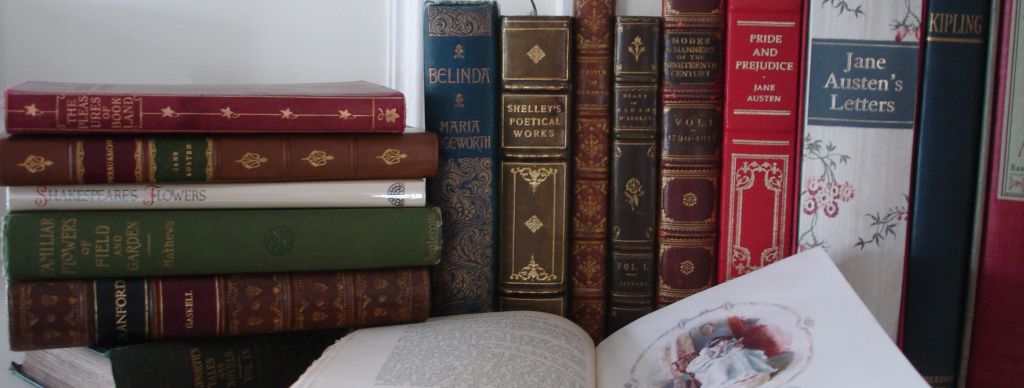
Now comes the hard part – with so much out there on Jane Austen, where do you even begin? The need to focus on one particular aspect [say just collecting copies of Pride and Prejudice], or by zeroing in on a certain illustrator you like [the Brock brothers], or only books with fine decorative bindings [so many] – this list covers the gamut of possibilities – you just need to choose what you are most interested in. You must however start with a core collection:
A. A Jane Austen Core Collection
1. The Works: the Oxford edition, ed. by Chapman (1923); the Cambridge edition, general editor Janet Todd, with each volume edited by a a different scholar; a set of reading copies of each novel – ones you can markup, underline, and make notes
2. The Letters – all editions [Brabourne, Chapman, Le Faye, Modert]
3. R. W. Chapman’s books on Jane Austen
4. Biography: the Memoir and everything since!
5. A Chronology of Jane Austen, Deirdre Le Faye (Cambridge, 2006)
6. The Bibliographies: Keynes, Chapman, Gilson, Barry Roth’s 3 volumes, and those continued annually in Persuasions; the Cambridge Bibliographies, etc…
7. Brian Southam. The Critical Heritage. Vol I. 1811-1870. Routledge, 1979; The Critical Heritage, Vol. II. 1870-1940. Routledge, 1987. – now available as digital reprints, 2009
8. Critical works: starting off point to further study – where to start?? The bibliographies; “Companions” – “Handbooks” – “Casebooks”
9. The World of Jane Austen: [endless material!]
- The Arts: Music, Art, Architecture; Interior Design and Decorative Arts; Landscape
- Georgian and Regency History: Political, Economic, Social, Religious
- Social life and customs: Etiquette; Gender / Class issues; Dancing; Costume and Fashion
- Domestic Arts: Cookery, Needlework, Women’s work, Family life, Home-life, Servants
- Medical History
- Military History: the Royal Navy, the Militia, The French Revolution, the American Revolution, Napoleonic Wars, War of 1812
- Geographical History and Maps
- Travel and Transportation: Carriages, Roads, Guidebooks, etc…
- Literary Theory, History of the Novel, Narrative Theory, Language
B. Collecting a specific Jane Austen novel: as an example Pride & Prejudice
- 1st editions
- American editions
- Specific Publishers: Bentley, Macmillan, Dent, Oxford, Folio Society, LLC, Penguin, etc.
- Translated editions
- Illustrators: also single illustrations
- Decorative bindings / cover art – to include paperbacks
- Critical editions: with scholarly editing and introductions
- Books where P&P shows up
- Association copies: e.g. Sarah Harriet Burney’s copy
- Books that influenced Austen: e.g. Frances Burney’s Cecilia
- Adaptations: Editions for young readers; Dramatizations; Films, Audiobooks
- Sequels! – endless potential!
- History / Social Life and Customs of the times, specific to P&P – fill your bookshelves!
- Ephemera and Physical Objects – P&P merchandise in popular culture, many to do with Colin Firth…(!)
*****************
Ok, now you know everything to know about Book Collecting – you can begin this lifelong fun-filled endeavor! Join me next week for the first of many [I hope] Jane Austen-related titles you must have on your shelves…all with Mr. Darcy’s approval. Any questions or suggestions, please comment.

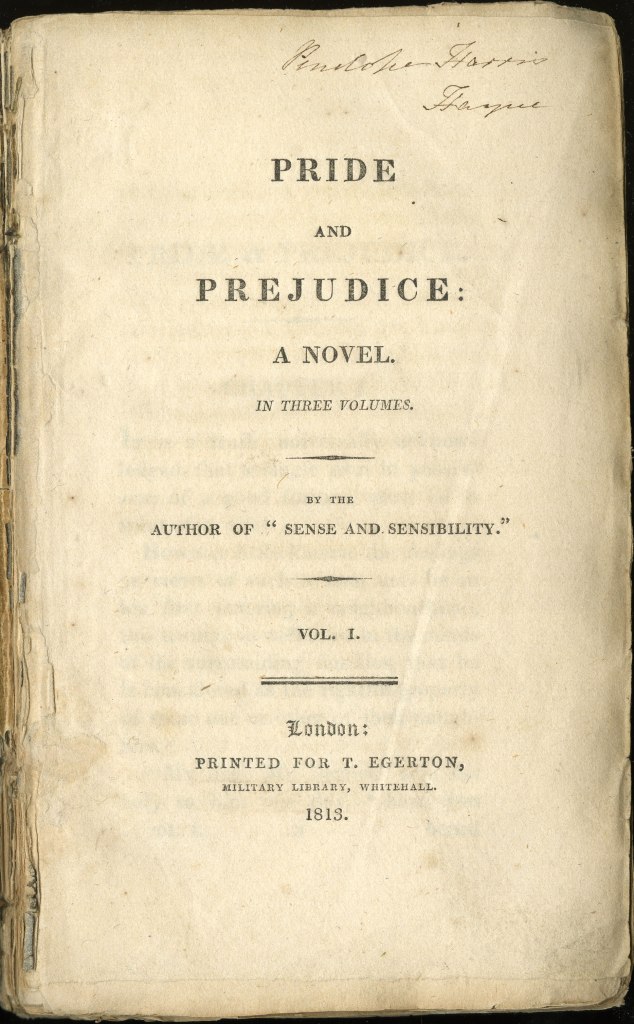
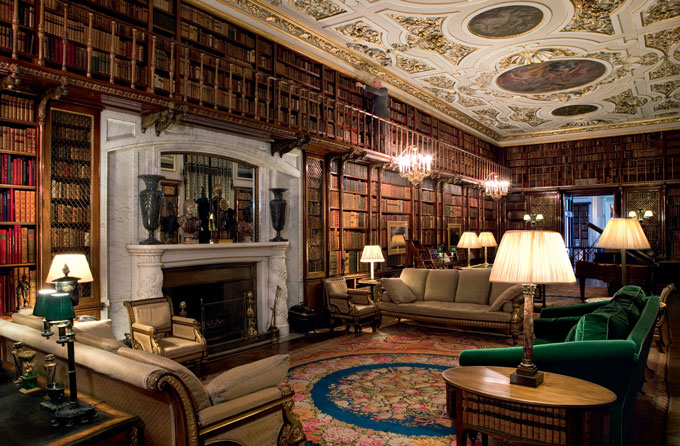
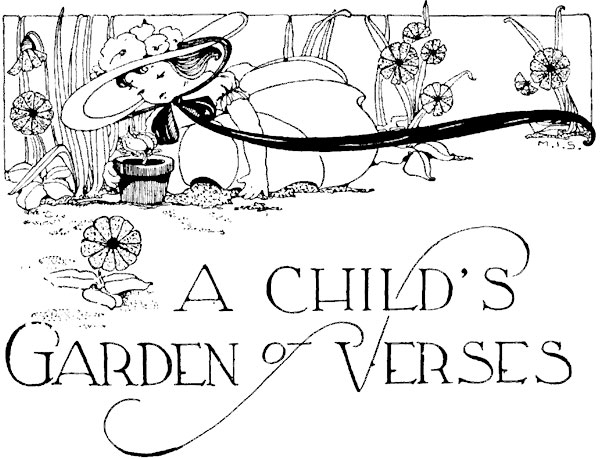
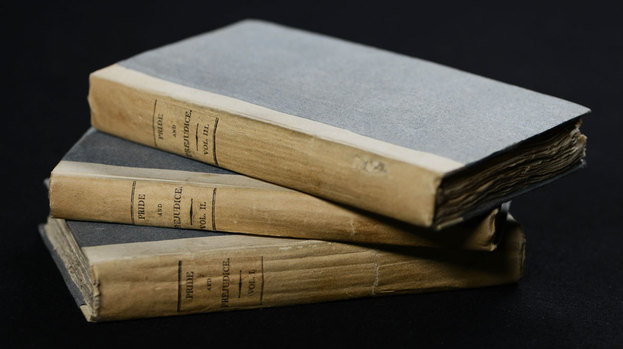
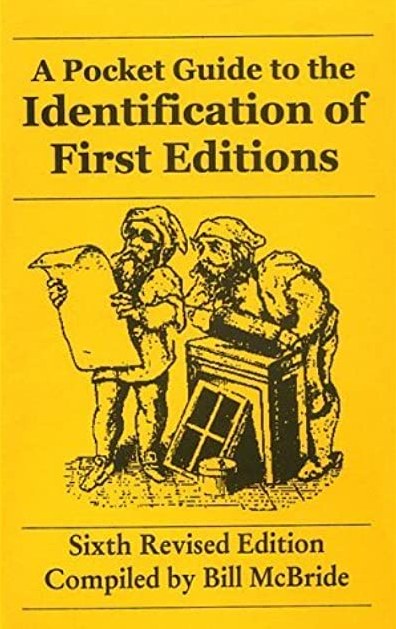

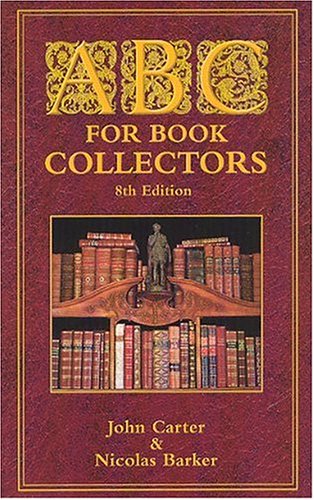
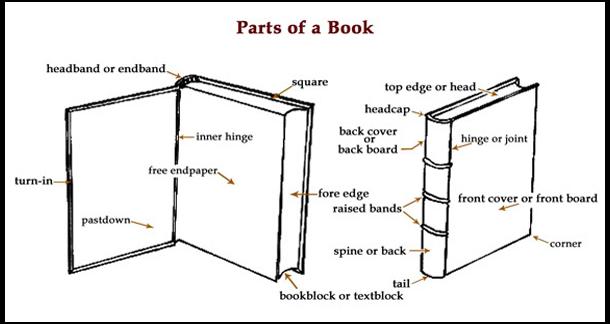
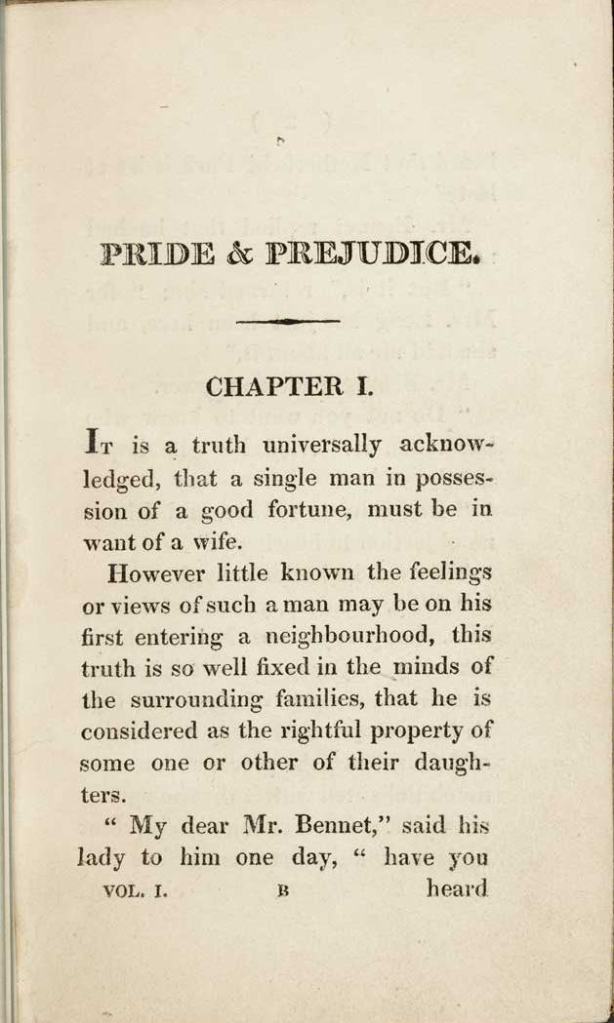
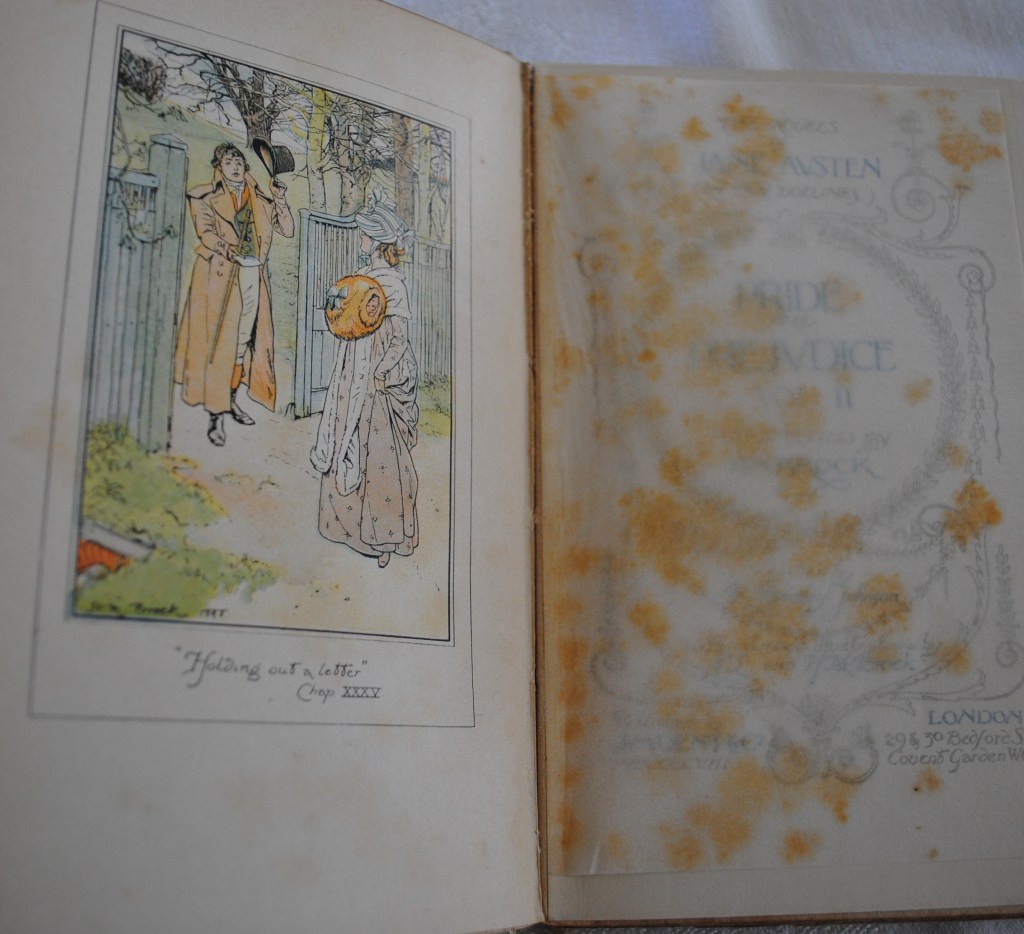
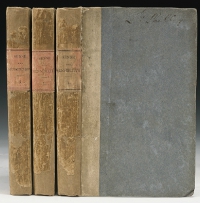
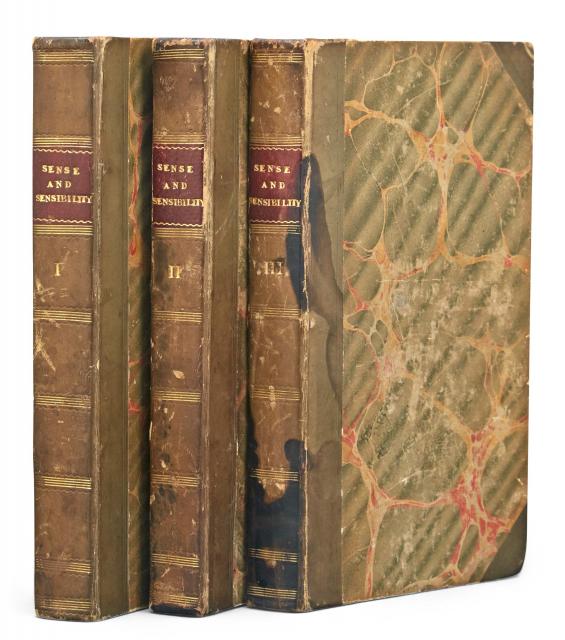
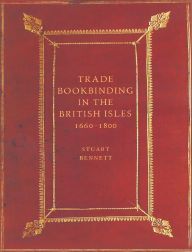
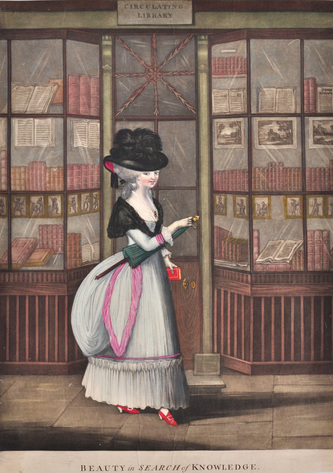
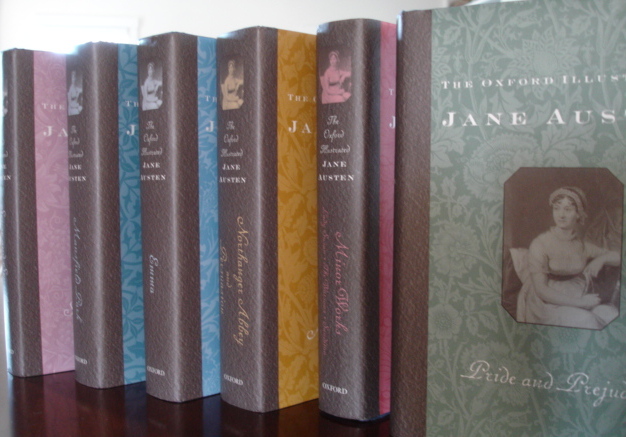
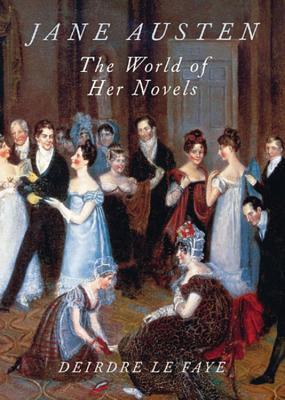
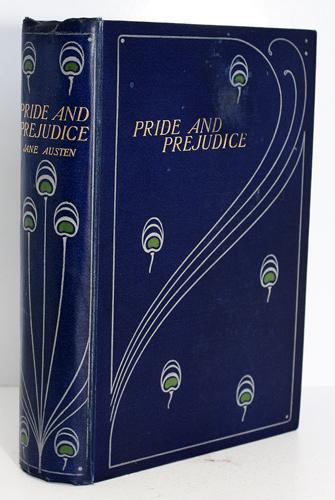
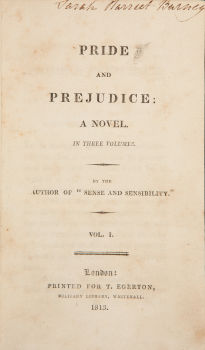
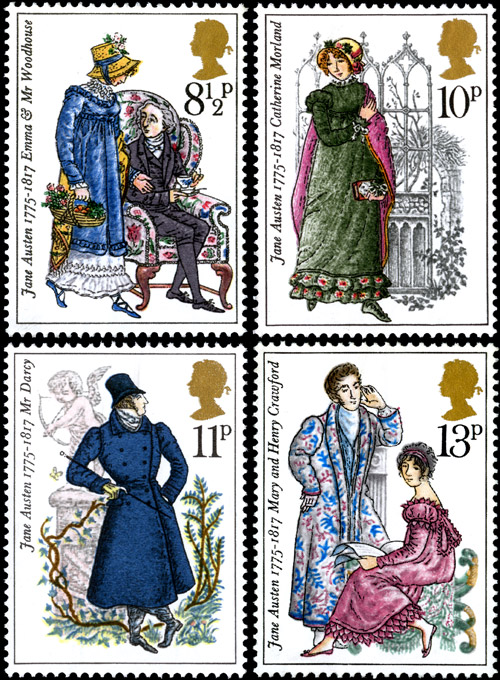
This is an amazing article. A world I knew nothing about until now. Great stuff, Deb. I have learned about collecting objects from a museum point of view but not books before. Tony.
LikeLiked by 2 people
Wonderful! Thank you for putting this together!
LikeLiked by 1 person
Interesting and useful article, thank you. i have several copies of P&P, none super valuable, but with covers i like. I also have a pbk copy of Sanditon only because the cover, inexplicably, is of a chicken looking at wallpaper. i love it!
LikeLike
Yes, it is the cover art that often draws us in, and what publishers have always played to – though I don’t get the chicken and wallpaper either! I’d love to see a picture of that. Thank you for visiting!
LikeLike
Pingback: Collecting Jane Austen: R. W. Chapman’s 1923 Oxford edition of the Novels – Jane Austen in Vermont
Pingback: “Perfect Happiness” on Viewing Four Jane Austen First Editions – JASNA Eastern Washington/Northern Idaho